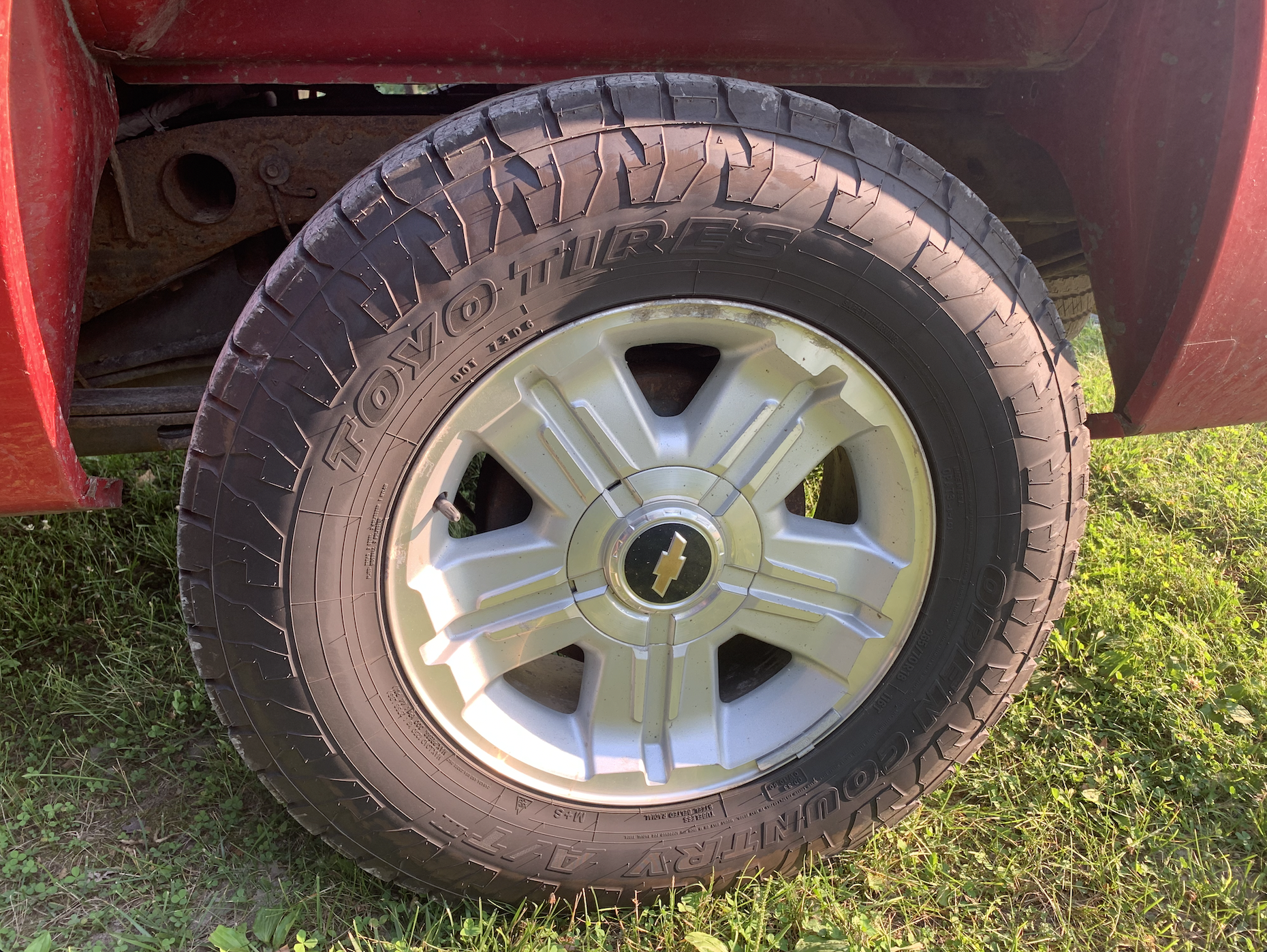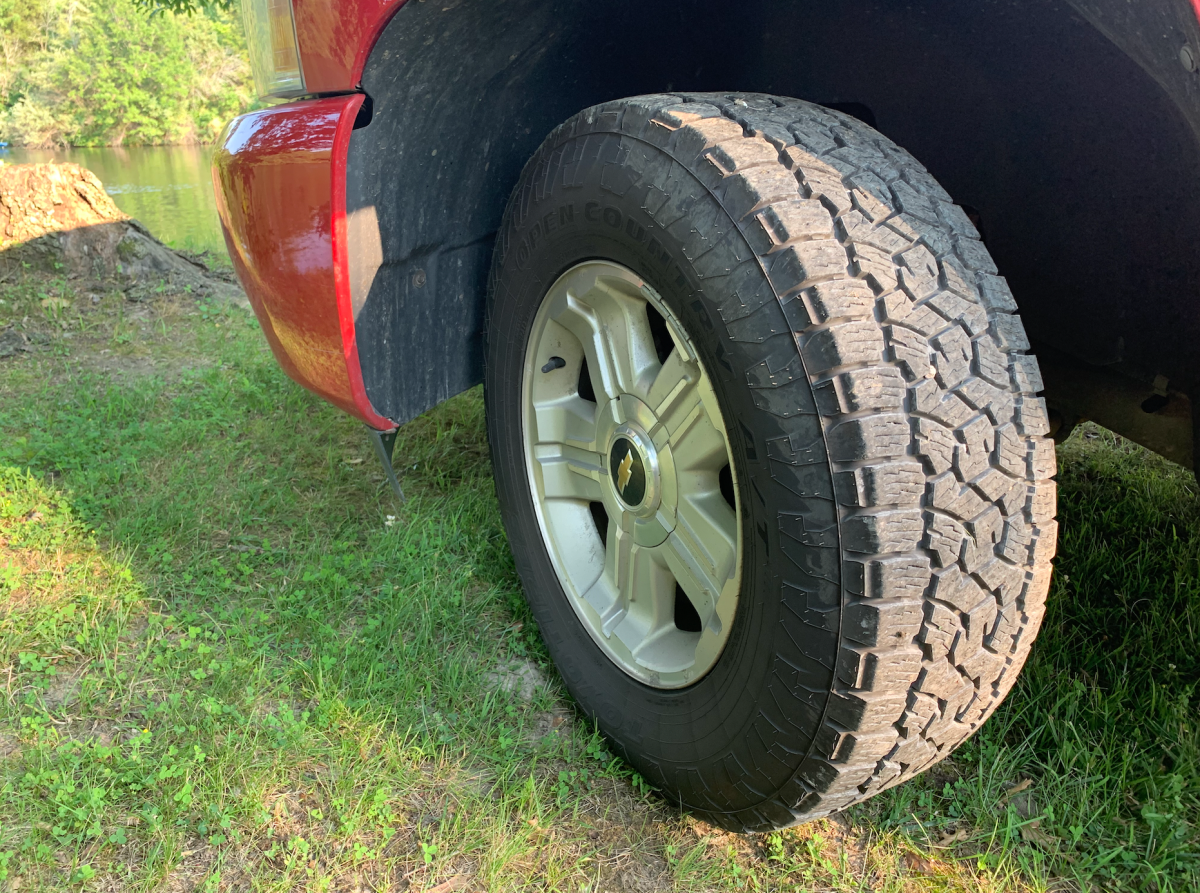We may earn revenue from the products available on this page and participate in affiliate programs. Learn More ›
I used to think putting four aftermarket tires on my truck was a waste of money. And honestly, depending on the way you hunt, it can be. If you park your pickup at the trailhead every Saturday in pursuit of mule deer or back a boat trailer into the public launch everyday of duck season, there’s no real reason to upgrade.
But if you have to maneuver a half-ton truck down a sloppy access road a few times a week or drive into a mud-sucked field the entirety of goose season, then outfitting your truck with aftermarket tires is a must.
I found that out the hard way after a year of hunting squirrels and rabbits on public land here in Illinois. For years, I have been a public duck hunter and there was no real need to have a set of all-terrain tires on my Chevy. But then I began to try and access public forests. Most public duck hunting venues had a reasonably hard surface to park on. Not so, with public timber.
It was often a shit show trying to access these small stands of woods. I’m talking a mile-long drive through soggy, rutted up roads. My stock tires always made it down the trail, but just barely. I was worried I’d end up stuck in a damn mud hole, and so I started looking at mud tires.
But what I found was the unless you are going from your home immediately into the mud, that style of tire really doesn’t make any sense. Most of us drive long distances on pavement and then occasionally need a tire that can tackle the mud. That’s one of the main reasons I settled on the Toyo Open Country A/T III—it’s an all-terrain tire that performs pretty damn well on the road and in the muck.
The A/T IIIs Makes Accessing the Backcountry Easy
Since I didn’t know anything about aftermarket truck tires, I hit up my friend Wes Siler, a former car magazine editor who knows all there is to know about autos and the best aftermarket upgrades to make to them. If you want more information on aftermarket tires, read this story. It will give you a comprehensive rundown of the importance of ditching those showroom floor tires in favor of all-terrains.
We chatted for a bit, and since I put a lot of on-pavement miles on my 2011 Silverado LT with occasional forays into muddy fields and down two-tracks, he suggested to go with the Toyos.
I was familiar with the brand, as all my duck guide buddies have a bald set of A/Ts on their favorite hunting truck. What really surprised me though was how much better my truck handled off-road with the Toyos on the wheels. I don’t typically drive into extremely hairy situations. I hunt alone a lot and am cautious of how far down the trail I go for fear of having to call a wrecker at 6 a.m. on a Sunday and paying the tow fee. Or worse yet, getting stuck so badly I’ll have to find someone with an excavator to dig me out.
The A/Ts, like a lot of quality all-terrains have good-sized gaps between the treads. This lets the tire get more grip when you take your truck off the beaten path. Those wider gaps allow the loose mud and dirt to fill that space so your tire can grip onto it instead of spinning like a standard tire will.
Toyo offers the A/T III in three different styles: Flotation, LT Metric, and P/Euro Metric. Each tread and shoulder design is slightly different, plus the tires will fit wheel sizes from 14 inches up to 22 inches. You also get a 65,000-mile warranty and can actually test-drive the tires for 500 miles.
Why the A/Ts Will Help Your Truck’s Performance

A lot of the guys and gals I hunt with don’t outfit their truck with all-terrains. I don’t look down my nose at those folks, because I was in the same boat not more than two years ago. Weekend hunters may never grasp the importance of an aftermarket tire upgrade, depending on how they hunt.
As I said earlier, if you pull into a gravel parking lot every time you hunt an all-terrain, like the Toyo A/T III is not a necessity. But if you take your truck into cut ag fields or down a greasy trail after a fresh rain, an aftermarket tire will completely change your driving experience.
To get to one of my favorite squirrel and rabbit hunting spots, I have to drive down one of the nastiest roads in Illinois. At times when it gets really wet, the site managers will place picnic tables at the entrance as a deterrent for hunters who want to access the property. If you want to get to the squirrels and cotton tops, you have to drive several miles around to a different access point and walk miles in.
With the Toyo A/T IIIs on, I just boogie around the tables. I’ve actually driven that particular road in stock tires and with the Toyos on, and the difference is unbelievable. With stock tires, my truck slides wherever the road and ruts decide to take it. In the A/Ts I can decide where my truck is going. Occasionally the mud will grab my tires and try to dictate it’s route, but I can always make a quick correction and get back on track.
Read Next: How to Build the Ultimate Hunting Truck
The Disadvantages of the Toyo A/T IIIs
This is pretty knit-picky and will happen with any aftermarket all-terrain tire you put on your truck, but I don’t get as good of gas mileage with the Toyos as I did with the stock tires.
That’s because showroom tires are built to run on-road while all-terrains are meant to play in both worlds: on- and off-pavement. So inherently they can not be as economical in terms of gas mileage. It’s a trade-off you just have to accept when you add all-terrains to your truck. Instead of getting 18 to 19 miles per gallon on highway, I’m around 17. City mileage is worse, but it’s worth it when I need to get out of a muddy field in the dark. (Besides, if you buy a truck in the first place you have to accept that it’s going to guzzle gas when you’re tooling around town.)
You won’t get as much grip on pavement with the A/T IIIs as you would with road tires, but it’s not noticeable enough that it should deter you from buying them. It’s common for rear-wheel drive trucks to experience slippage when there’s moisture on the road. It’s exacerbated by the A/T IIIs (when you’re not in four-wheel drive). If it’s raining, snowing, or the road is wet and you try and accelerate quickly, the tires will spin if the truck is in two-wheel drive. But that’s the case with most any truck tire. My truck drove phenomenally in the snow when in four-wheel drive.
Overall, the Toyo A/T IIIs have been a delight to drive. They added around 2 inches of ground clearance to my Silverado, and there’s no terrain I hunt that the tires can’t handle, which is important when you’re heading afield on your own.
